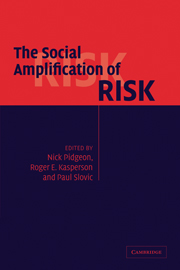Book contents
- Frontmatter
- Contents
- List of figures
- List of tables
- List of contributors
- Acknowledgments
- Introduction
- Part I Conceptual foundations
- Part II Risk signals and the mass media
- Part III Public perceptions and social controversy
- 9 The dynamics of risk amplification and attenuation in context: a French case study
- 10 Public response to Y2K: social amplification and risk adaptation: or, “how I learned to stop worrying and love Y2K”
- 11 The social dynamics of environmental risk perception: implications for risk communication research and practice
- 12 Understanding amplification of complex risk issues: the risk story model applied to the EMF case
- Part IV Risk ripples and stigma effects
- Part V Policy and management
- Bibliography
- Index
12 - Understanding amplification of complex risk issues: the risk story model applied to the EMF case
Published online by Cambridge University Press: 06 July 2010
- Frontmatter
- Contents
- List of figures
- List of tables
- List of contributors
- Acknowledgments
- Introduction
- Part I Conceptual foundations
- Part II Risk signals and the mass media
- Part III Public perceptions and social controversy
- 9 The dynamics of risk amplification and attenuation in context: a French case study
- 10 Public response to Y2K: social amplification and risk adaptation: or, “how I learned to stop worrying and love Y2K”
- 11 The social dynamics of environmental risk perception: implications for risk communication research and practice
- 12 Understanding amplification of complex risk issues: the risk story model applied to the EMF case
- Part IV Risk ripples and stigma effects
- Part V Policy and management
- Bibliography
- Index
Summary
This chapter outlines a new concept for risk amplification: the risk story model. The starting-point is the well-known conflict situation of risk evaluation as seen by experts and laypersons. To address this conflict, a typology of risk issues can be developed, based on the different risk communication challenges. Laypersons may perceive each type of risk issue as a different risk story. In the second part of the chapter, the relationship between risk stories and social risk amplification is explored. Examples of radio frequency electromagnetic fields (RF EMF) issues are used to illustrate the approach to understanding risk perception and communication. Furthermore, empirical data are provided that support the basic assumption of a risk story model. Finally, the consequences for EMF issues and risk communication in general are discussed.
Experts and laypersons: two views on risks
Experts
Experts and laypersons perceive risks differently. Experts see risks as possible chains of cause-and-effect. They regard risks as indicators of hazard potentials. Risk assessment involves answering four questions: Is there a potential hazard and what is its nature? What dose will induce a harmful effect? Who is exposed to what dosage? How significant is the risk?
Figure 12.1 shows the challenges associated with assessing risks, and what – in the view of the experts – the assessment ought to take into account. For the experts, the crucial point is whether and with what degree of confidence the risk can be assessed.
Information
- Type
- Chapter
- Information
- The Social Amplification of Risk , pp. 286 - 302Publisher: Cambridge University PressPrint publication year: 2003
Accessibility standard: Unknown
Why this information is here
This section outlines the accessibility features of this content - including support for screen readers, full keyboard navigation and high-contrast display options. This may not be relevant for you.Accessibility Information
- 23
- Cited by
